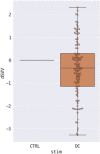Vestibular Extremely Low-Frequency Magnetic and Electric Stimulation Effects on Human Subjective Visual Vertical Perception
- PMID: 35801487
- PMCID: PMC9541167
- DOI: 10.1002/bem.22417
Vestibular Extremely Low-Frequency Magnetic and Electric Stimulation Effects on Human Subjective Visual Vertical Perception
Abstract
Electric fields from both extremely low-frequency magnetic fields (ELF-MF) and alternating current (AC) stimulations impact human neurophysiology. As the retinal photoreceptors, vestibular hair cells are graded potential cells and are sensitive to electric fields. Electrophosphene and magnetophosphene literature suggests different impacts of AC and ELF-MF on the vestibular hair cells. Furthermore, while AC modulates the vestibular system more globally, lateral ELF-MF stimulations could be more utricular specific. Therefore, to further address the impact of ELF-MF-induced electric fields on the human vestibular system and the potential differences with AC stimulations, we investigated the effects of both stimulation modalities on the perception of verticality using a subjective visual vertical (SVV) paradigm. For similar levels of SVV precision, the ELF-MF condition required more time to adjust SVV, and SVV variability was higher with ELF-MF than with AC vestibular-specific stimulations. Yet, the differences between AC and ELF-MF stimulations were small. Overall, this study highlights small differences between AC and ELF-MF vestibular stimulations, underlines a potential utricular contribution, and has implications for international exposure guidelines and standards. © 2022 Bioelectromagnetics Society.
Keywords: alternating current stimulation; extremely low-frequency magnetic fields; human vestibular system; magnetic induction; subjective visual vertical.
© 2022 The Authors. Bioelectromagnetics published by Wiley Periodicals LLC on behalf of Bioelectromagnetics Society.
Figures





Similar articles
-
Characterization of Levels of Extremely Low Frequency Magnetic Fields Emitted From Portable Hand-Held Fans.Bioelectromagnetics. 2019 Dec;40(8):569-577. doi: 10.1002/bem.22210. Epub 2019 Aug 2. Bioelectromagnetics. 2019. PMID: 31373404
-
Thresholds and mechanisms of human magnetophosphene perception induced by low frequency sinusoidal magnetic fields.Brain Stimul. 2024 May-Jun;17(3):668-675. doi: 10.1016/j.brs.2024.05.004. Epub 2024 May 11. Brain Stimul. 2024. PMID: 38740182
-
Impact of extremely low-frequency magnetic fields on human postural control.Exp Brain Res. 2019 Mar;237(3):611-623. doi: 10.1007/s00221-018-5442-9. Epub 2018 Dec 5. Exp Brain Res. 2019. PMID: 30519897
-
Characteristics of Peak Exposure of Semiconductor Workers to Extremely Low-Frequency Magnetic Fields.Ann Work Expo Health. 2023 Apr 21;67(4):508-517. doi: 10.1093/annweh/wxad003. Ann Work Expo Health. 2023. PMID: 36857508 Review.
-
Induced electric fields in MRI settings and electric vestibular stimulations: same vestibular effects?Exp Brain Res. 2024 Nov;242(11):2493-2507. doi: 10.1007/s00221-024-06910-y. Epub 2024 Sep 11. Exp Brain Res. 2024. PMID: 39261353 Review.
Cited by
-
Stimulus effects of extremely low-frequency electric field exposure on calcium oscillations in a human cortical spheroid.Bioelectromagnetics. 2025 Jan;46(1):e22521. doi: 10.1002/bem.22521. Epub 2024 Aug 25. Bioelectromagnetics. 2025. PMID: 39183508 Free PMC article.
-
Unpacking Galvanic Vestibular Stimulation using simulations and relating current flow to reported motions: Comparison across common and specialized electrode placements.PLoS One. 2024 Aug 26;19(8):e0309007. doi: 10.1371/journal.pone.0309007. eCollection 2024. PLoS One. 2024. PMID: 39186497 Free PMC article.
-
Biological Effects of Magnetic Storms and ELF Magnetic Fields.Biology (Basel). 2023 Dec 8;12(12):1506. doi: 10.3390/biology12121506. Biology (Basel). 2023. PMID: 38132332 Free PMC article. Review.
References
-
- Akin FW, Murnane O. 2009. Subjective visual vertical test. Semin Hear 30:281–286.
-
- Angelaki DE, Cullen KE. 2008. Vestibular system: The many facets of a multimodal sense. Annu Rev Neurosci 31:125–150. - PubMed
-
- Antal A, Alekseichuk I, Bikson M, Brockmöller J, Brunoni AR, Chen R, Cohen LG, Dowthwaite G, Ellrich J, Flöel A, Fregni F, George MS, Hamilton R, Haueisen J, Herrmann CS, Hummel FC, Lefaucheur JP, Liebetanz D, Loo CK, McCaig CD, Miniussi C, Miranda PC, Moliadze V, Nitsche MA, Nowak R, Padberg F, Pascual‐Leone A, Poppendieck W, Priori A, Rossi S, Rossini PM, Rothwell J, Rueger MA, Ruffini G, Schellhorn K, Siebner HR, Ugawa Y, Wexler A, Ziemann U, Hallett M, Paulus W. 2017. Low intensity transcranial electric stimulation: Safety, ethical, legal regulatory and application guidelines. Clin Neurophysiol 128:1774–1809. - PMC - PubMed
-
- Arzy S, Collette S, Ionta S, Fornari E, Blanke O. 2009. Subjective mental time: The functional architecture of projecting the self to past and future. Eur J Neurosci 30:2009–2017. - PubMed
-
- Attwell D. 2003. Interaction of low frequency electric fields with the nervous system: The retina as a model system. Radiat Prot Dosimetry 106:341–348. - PubMed
MeSH terms
Grants and funding
LinkOut - more resources
Full Text Sources
Research Materials

